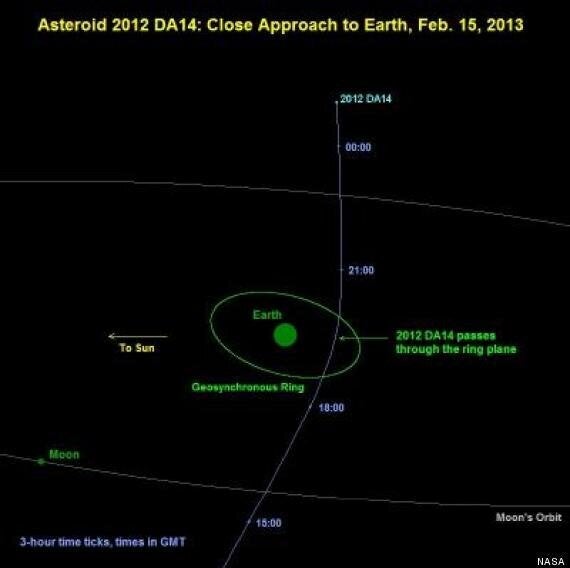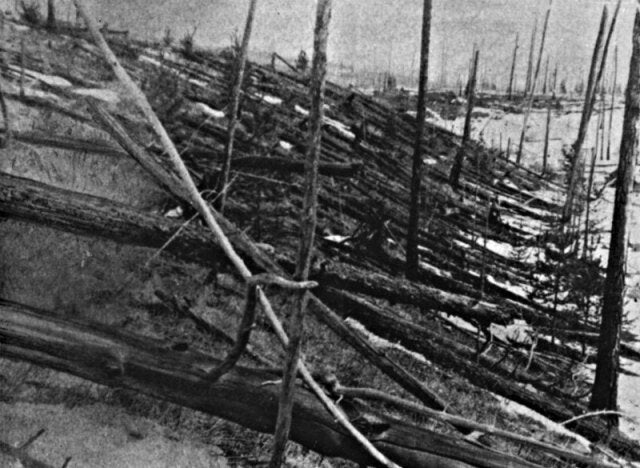An asteroid capable of destroying London will skim past the Earth on Friday, approaching closer than many satellites.
Scientists say they are sure there is no chance of the 150ft (45.7m) wide space rock hitting the planet.
But there is a remote possibility that it could collide with one of more than 100 telecommunication and weather satellites in fixed orbits above the Earth.

A simulation of 2012 DA14 by Nasa. The 150-foot object will pass within 17,000 miles of the Earth.
The asteroid, 2012 DA14, has been closely tracked since its discovery a year ago.
It is predicted to reach its nearest point to the Earth at around 7.30pm UK time on Friday.
Experts have calculated it will stay at least 17,200 miles (27,681km) away - easily far enough to be safe, but a very close shave in astronomical terms. Scientists have never observed such a narrow miss before.

Near miss: Asteroid 2012 DA14 will skim past the Earth on February 15
Through binoculars, the object should be visible as a tiny dot of light crossing the sky.
Astronomer and asteroid expert Dr Dan Brown, from Nottingham Trent University, said: "It will be too faint for the naked eye but with binoculars it should be visible if you know where to look. It will be low to the north-eastern horizon and moving quite quickly.
"You'll be able to see it pass from the constellation Leo to roughly the Plough, more or less from anywhere in the UK, and it will be bright for about an hour."
DA14 belongs to dangerous family of near-Earth objects (NEOs) that are small enough to be missed but large enough to cause serious damage.
It was detected in February last year by La Sagra Observatory in southern Spain as it fell under the spotlight of the Sun's rays.
Travelling at between 12,427mph (20,000kph) and 18,641mph (30,000kph) - around five miles (8km) a second, or eight times the speed of a rifle bullet - the asteroid will fly inside the orbits of high geostationary satellites some 22,000 miles (35,406km) above the Earth.
"These are the satellites that provide us with telecommunications and weather forecasts," said Dr Brown.
"There are loads of them but you're talking about a very big area. It would be very unlucky if a satellite was hit. The asteroid is more likely to hit some space junk, but most of this is only about a centimetre across and the impact won't even be noticed."
Precise calculations showed there was absolutely no possibility of DA14 hitting the Earth, Dr Brown said.
But scientists had a good idea of what the effect of such an impact would be because a similar sized meteor devastated a remote region of Siberia in 1908.

Trees felled at Tunguska
Exploding a short distance above the ground over Tunguska, the object generated a blast 1,000 times more powerful than the atom bomb dropped on Hiroshima. Forest was completely flattened over an area of 830 square miles (2,150 sq km).
"We think the object that impacted at Tunguska would have been of a similar size to DA14," said Dr Brown.
"Actually, it exploded in the air. It didn't destroy humanity, but if this object had exploded over London it would have wiped out London. It's not a global impact, but it's a severe impact."
The "Hollywood option" of blowing up an incoming asteroid has been ruled out by experts. Such a dramatic solution would only result in deadly debris raining down on Earth. Instead, scientists are looking at ways of gently nudging an asteroid onto a safer trajectory.
A future mission planned by the American space agency Nasa, called Dart, will fire a probe into an asteroid to see if it can be moved. However, this may not be for another 10 or 20 years, said Dr Brown.
Meanwhile astronomers are currently tracking up to 400 NEOs that, like DA14, have been categorised as a potential threat. While a number are about the same size as DA14 "there will also be some considerably larger," Dr Brown added.
The American space agency Nasa launched its NEO programme 15 years ago with the aim of finding all "extinction event" asteroids and comets 0.62 miles (1km) across and larger. Later, it started focusing on smaller objects.